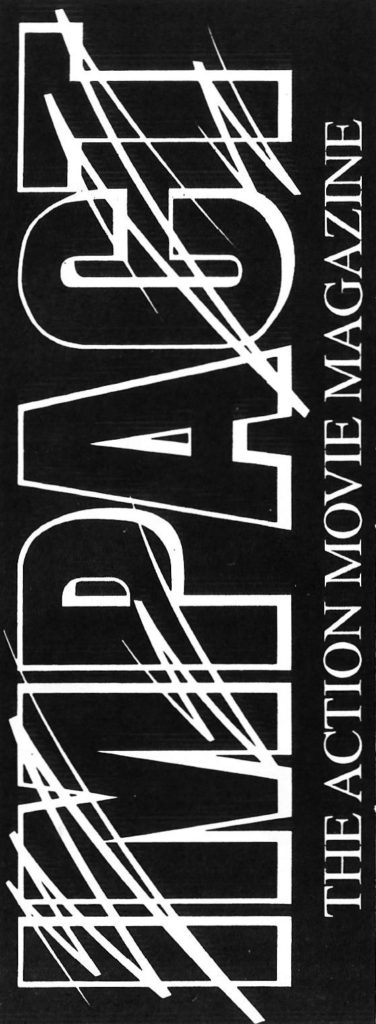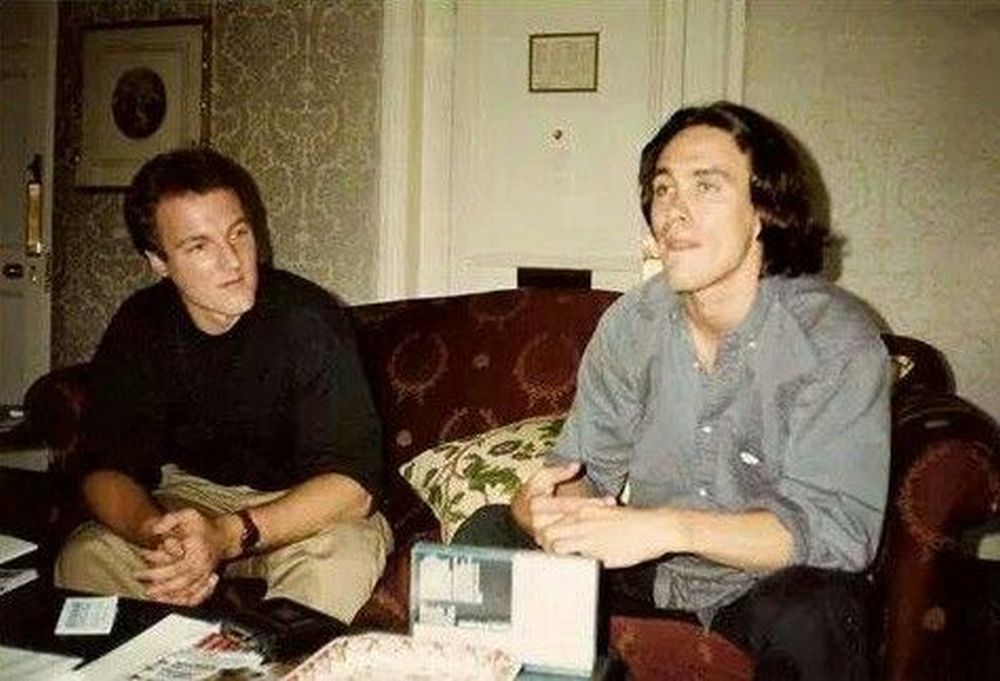“The Good, The Bad and The Dangerous”
Recently, TC was able to talk to three hard working Martial Arts personalities, during a hectic SF convention at the Arcadian Hotel in Birmingham.
John Carrigan is a self-professed “action-actor” and martial artist, the guiding light behind ‘Heroes For Hire’, a stunt team demonstrating fighting arts at charity events, and an actor in his own right. He’s appeared in ‘The Bill’, ‘The Chronicles of Narnia’, ‘Lovejoy’, ‘ST:TNG’, the movie ‘Double X’, and a recent independent drama, the Twilight Zone-styled ‘Hollow Man’.
Po-Ling Choi is described as a Hong Kong “action-actress extraordinaire”, and as well as working on ‘Impact’ with Bey, has appeared in several features, including the “quickie” The Good, The Bad and the Dangerous, filmed in the very hotel this interview was conducted (and also provided this article’s title!).
Bey Logan edits ‘Impact’, the martial arts/action film magazine, as well as being a writer-producer working in the UK & HK. He is half of Beymark International, a production company dedicated to producing Anglo-Eastern action films. Recently, he acted as Line Producer on “Killer’s Romance”, inspired by ‘Crying Freeman’, and available on Colourbox Video.

What inspired you to start in martial arts?
PLC: In Hong Kong, it’s traditional that when you’re young, if your father or relatives do martial arts, then you do martial arts as well. It’s a popular thing for girls to do kung fu in films now, so that’s why I’ve started doing the same.
BL: What got me involved was initially Bruce Lee. I think that probably 99% of people in this country involved in martial arts and martial arts movie-making were probably inspired by him.
JC: My involvement came just before Bruce Lee because I got beaten up quite badly in 1972 by six individuals, and I thought I either dig a hole or do something about it. David Carradine spun onto the scene and I saw a few episodes of ‘Kung Fu’. I thought he was good until I went to see ‘The Big Boss’ with Bruce Lee and that was the springboard. It was basically self-defence and then Bruce.
You’ve described yourselves as “action-actors”. What came first? Was it the martial arts, the stunt work, and then you decided to move into acting?
PLC: I was acting before – I was interested in acting when I was a child, and then with the rise of kung-fu women in movies, I added the kung fu. I was acting before kung-fu women were popular.
What do you find the hardest part of your career?
PLC: Remembering the moves during fight scenes. Not to get hit, to hit the right people.
BL: The hardest thing for me is getting financing for films. I’ve got a lot of ideas, and there’s tremendous potential in our stunt team and the people around us. That’s why it’s great: the thing we did here at the Arcadian, John’s film “Hollow Man” – that’s the way things get done. But the biggest stumbling block to creativity is that it is show business, and without the business, there ain’t no show.
JC: The hardest thing is to keep the dream alive, through the days when you think “I’ll never get there”, and not to listen to yourself, to keep the enthusiasm, to pass it on.
Have you ever been hurt?
JC: I’ve been hurt too numerous times to mention in martial arts, because when you train six days a week, you hitch up some marks. We say it’s not the years, it’s the mileage! In films, in stunt work, I’ve had loads of minor things. I did a twenty-five foot roof fall where you somersault, and for every six feet you fall, you go a foot out – when I got to the boxes, my kneecap went over the side of the box and almost snapped the wrong way. It took me 3 months to get right from that. And I dislocated my ankle, and the bone burst through the side of my foot…
How do you feel about the risks?
JC: It goes with the territory. I don’t just want to be a stuntman and burst into flames. If I’m going to do something like “Hollow Man”, if I did get injured, I want people to know it was me doing it, me as the character I was playing, then it’s worth it. But if I step in for a character who gets all the glory, and I get badly injured for five seconds of footage, it’s not justified because my living is my body.
Have you ever consider going behind the cameras, perhaps directing?
PLC: I don’t really know how to direct. In Hong Kong it’s very difficult for females. There are no female directors who have come from being actresses.
JC: I’d like to be in both places! I’ve not been trained as a director, but I know what I like to see, and I know how I feel when I’ve been directed, and I know what I think was wrong when I was directed. Whenever I’m on a film set, I’m never sitting around chewing my nails, I’m always with the make-up people, the directors, producers, sound-men, trying to learn and assimilate what the total picture is – a bit like a martial art, you try and get the total picture, rahter than just a segment. I’d love to direct – maybe one day…

Who are you favourite martial arts actors? [NB This interview took place before the unfortunate death of Brandon Lee]
PLC: Jackie Chan in Hong Kong, and Sashi Mitchell in the West.
BL: In the States, I like Brandon Lee and Thomas Ian Griffith, who has made a film called ‘Excessive Force’ which is really brilliant. These are two guys who are coming up, who are well worth checking out, trust me on that! From Hong Kong, it’s got to be Donnie Yen, who’s a good friend of mine, but I think pound-for-pound he’s the finest martial arts actor in the world.
JC: From the past, it has to be Bruce Lee. I think Brandon Lee is going to take the world by storm very soon. I think Van Damme is good, but I don’t like the re-use of the same kick over and over, it’s getting to be the ruination of some films. Cynthia Rothrock uses it all the time now. I think Bruce Lee and Brandon Lee. Steven Seagal has presence, not much as a martial artist, even though he’s very effective, but as a person.
What’s your opinions of the Western martial arts actors in general?
PLC: They’re pretty rubbish! I don’t like watching them.
BL: I think a head-to-head comparison is unfair. In Hong Kong, you have actors doing martial arts, and in America, you’ve martial artists learning how to act. In Hong Kong, they try to do martial arts in a theatrical way, which will entertain that audience – it’s one reason films don’t translate well in the West. In America, they’re basically trying to show real martial arts, aikido, kickboxing, whatever; there’s a kind of reality there. It’s interesting to see cross-pollination, like Brandon Lee’s “Rapid Fire” which combines the two, with the grittiness of a Seagal movie, but the action sequences are very theatrical and Hong Kong style. That movie, I think, is the first one to bridge the gap between the two.
JC: If you could get a balance between East and West as Bey says. Samo Hung, what he does is incredible, but Western audiences wouldn’t pay just to see him as a character – with the fight scenes, they would. If you can get that kind of action with the quality acting that some people do… I recognise the distinction between Chinese and Western – they both have their merits.
This next question is perhaps something of a controversial one…
BL: Fire away, I love controversy!
It’s said that some movies are shot at 21 to 22 frames per second, and then shown at the full 24 frames per second to give an illusion of speed. How true it this?
BL: I don’t think it’s controversial, that’s a technique of film- making that’s used in Hong Kong and again it’s to do with the theatrical nature of it. They’re not interested in realism. Their attitude is that we are filming a live action cartoon in which people happen to hit each other, and one of the aspects of cartoon making is that the pace of action is substantially faster than real human beings move – that translates onto the screen. But I’d say, if you don’t like it, if that sounds fake to you, look at the last reel of ‘Showdown in Little Tokyo’ and the last reel of ‘Police Story’ with an audience who like that kind of movie. Not the whole film, just the last reel. And then take a straw poll to see who liked what film…
So you would say that undercranking the camera in a martial arts film is like the special effects in a science fiction movie?
BL: Absolutely.
How true are the stories about Triad involvement in the HK movie industry?
BL: Triads are a fact of life in Hong Kong – they always have been in Chinese culture. The problem is that they have stepped up their involvement, more people getting greedier. One of the famous ploys that causes a lot of problems is when they go to a famous actor, set up a temporary money- laundering operation, a small film company, and say to the actor, “Do a film for us at 1/3 of your normal rate, as a favour to the ‘boys'”. The gang will release this movie and after a couple of months they close up the company, take the money and run. In principle, that worked okay.
Now, you get ten guys saying to this actor, “Please do this film”, and the actor’s thinking “I’ll be doing a year’s worth of films for no money, I don’t want to do that”, and the ones he says “No” to are the ones who are getting stroppy. This is where you hear about managers getting kidnapped, and all the other horrible stuff going on. I think it’s not that the Triads are involved with the film-making, whether that’s good or bad is immaterial, it happens. What I think is the problem is that there has been an unrealistic approach to the film industry by the Triads, and that is the cause of the recent problems, and the march and the protests. It wasn’t actually Artists Against Triads, it was Artists Against Violence – violence being perpetrated against actors or actors’ managers.
Do you think it’s less sinister to the people who are involved than it appears to us from a Western viewpoint?
BL: Much as it would be great if these things didn’t exist, they will exist, they’ve always existed , and whether they are benevolent or malign depends on which side of the fence you are on. Certainly, everything Oriental has a mystique to it; that’s as true for the gangs as anything else.
[Thanks to the three interviewees for their time, and a special tip of the TC hat to Bey Logan for translating for Po-Ling]

Ouch!
Truckee, California – A tree trimmer who was found with his throat cut committed suicide with a chainsaw. investigators said on Wednesday. Officials believed it was the first such suicide in the United States; Richard Possehl. 27, was found dead near his pickup truck in Truckee, Eastern California. on June 27. the Nevada County sheriff’s department said. His neck and spinal cord were cut and a chainsaw was found lying next to the body. State Department of Justice officials recreated the killing to show it was possible for Possehl to have committed suicide in this way.